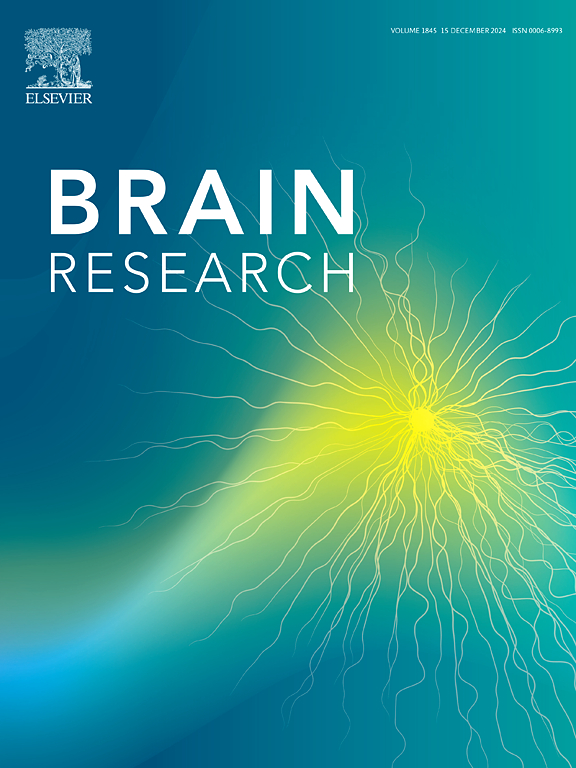HIF-1α沉默在大鼠后代妊娠晚期缺氧诱导的自闭症样行为中的作用
IF 2.7
4区 医学
Q3 NEUROSCIENCES
引用次数: 0
摘要
自闭症谱系障碍(ASD)是一种神经发育障碍,可由多种因素引起。我们之前的研究表明,缺氧诱导因子1α (HIF-1α)在缺氧引起的自闭症样行为中起作用。本研究通过在体内研究HIF-1α参与产前缺氧诱导的自闭症样行为的机制,为ASD的治疗提供实验依据。我们将怀孕17天的大鼠置于自制的含氧10%±0.5%的氮气缺氧腔中,建立了妊娠大鼠的产前缺氧模型。在出生后24小时内,在产前缺氧的子代大鼠侧脑室注射重组腺相关病毒,以沉默HIF-1α的表达。与产前缺氧组相比,HIF-1α沉默组子代大鼠的自闭症行为明显减轻。随着HIF-1α的沉默,磷酸酶和紧张素同源物(PTEN)的活性升高,PI3K/AKT通路受到负反馈抑制。Si-HIF-1α沉默组血管内皮生长因子(VEGF) mRNA表达水平降低,n -甲基d -天冬氨酸受体亚型2 (NR2A)表达下调。因此,我们的研究表明HIF-1α在缺氧诱导的自闭症样行为中发挥作用,其调节作用可能是通过抑制PTEN的活性,从而激活PI3K信号通路来实现的。突触可塑性调节也可能参与其中。本文章由计算机程序翻译,如有差异,请以英文原文为准。
The role of HIF-1α silencing in late pregnancy hypoxia-induced autism-like behavior in rat offspring
Autism spectrum disorder (ASD) is a neurodevelopmental disorder that can be caused by a variety of factors. Our previous study indicated that hypoxia-inducible factor 1 alpha (HIF-1α) plays a role in hypoxia-caused autism-like behavior. In this study, we investigated the mechanism by which HIF-1α contributes to prenatal hypoxia-induced autism-like behavior in vivo to provide an experimental basis for the treatment of ASD. We established a prenatal hypoxia model of pregnant rats by placing 17-day pregnant rats into a self-made hypoxia chamber filled with a nitrogen containing 10 %±0.5 % oxygen. Within 24 h after birth, the lateral ventricles of the prenatal hypoxia offspring rats were injected with a recombinant adeno-associated virus designed to silence HIF-1α expression. The autistic behavior of offspring rats in the HIF-1α silenced group was significantly alleviated compared with that of the prenatal hypoxia group. With the silencing of HIF-1α, the activity of phosphatase and tensin homolog (PTEN) increased and the PI3K/AKT pathway was inhibited by negative feedback. The mRNA expression level of vascular endothelial growth factor (VEGF) was decreased in the Si-HIF-1α silenced group and N-methyl D-aspartate receptor subtype 2 (NR2A) expression was downregulated. Thus, our study indicates that HIF-1α plays a role in hypoxia-induced autism-like behavior, and its regulatory effect may be achieved by inhibiting the activity of PTEN, resulting in activation of the PI3K signaling pathway. Synaptic plasticity regulation may also be involved.
求助全文
通过发布文献求助,成功后即可免费获取论文全文。
去求助
来源期刊

Brain Research
医学-神经科学
CiteScore
5.90
自引率
3.40%
发文量
268
审稿时长
47 days
期刊介绍:
An international multidisciplinary journal devoted to fundamental research in the brain sciences.
Brain Research publishes papers reporting interdisciplinary investigations of nervous system structure and function that are of general interest to the international community of neuroscientists. As is evident from the journals name, its scope is broad, ranging from cellular and molecular studies through systems neuroscience, cognition and disease. Invited reviews are also published; suggestions for and inquiries about potential reviews are welcomed.
With the appearance of the final issue of the 2011 subscription, Vol. 67/1-2 (24 June 2011), Brain Research Reviews has ceased publication as a distinct journal separate from Brain Research. Review articles accepted for Brain Research are now published in that journal.
 求助内容:
求助内容: 应助结果提醒方式:
应助结果提醒方式:


